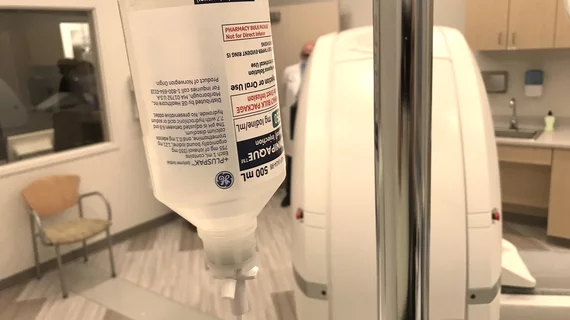AHA presses GE for a detailed progress report on CT contrast shortage
The American Hospital Association is asking GE Healthcare to more fully apprise AHA’s nearly 5,000 member organizations of what the company is doing to help ameliorate the ongoing disruption in supplies of Omnipaque (iohexol).
In a May 16 letter addressed to GE Healthcare GM Greg Eppink, AHA writes:
Specifically, we are concerned that the limited availability of Omnipaque products could present significant care delivery challenges for our members, and we ask that GE provide additional information surrounding the current shortage that would be useful in managing care for patients.”
The letter’s sole signatory is Ashley B. Thompson, the AHA’s senior VP of public policy analysis and development.
After outlining the situation from the provider’s eye view—including the effects of alternative CT contrast agent Visipaque also falling behind in order fulfillment—Thompson thanks Eppink for the mitigating steps GE has already taken. These include notifying customers and other stakeholders of supply chain status, reopening GE’s Shanghai plant at 25% capacity and transferring some Omnipaque production to Cork, Ireland.
“However, there are several critical issues that require further explanation or clarification so that all involved can navigate the challenges caused by the shortage of Omnipaque,” she states. “Specifically, it would be immensely helpful if GE could address” five particular matters:
1. Allotment expectations. “To ensure hospitals and health systems can plan ahead, it would be helpful for GE to provide a clearer set of expectations [than the current 20% allotted] for how allocations will be managed moving forward,” Thompson writes, “including anticipated projections for increases in allocation based on improvements in GE production and distribution.”
2. Prioritizing distribution for the most critical services. Thompson suggests designated stroke centers, heart centers, oncology centers and busy ERs deserve special consideration from GE as it allots available contrast supplies. “Can GE provide a clearer set of details pertaining to how prioritization is being done,” Thompson asks, “and whether it is considering the patient care services being provided in making those allocation decisions? What steps is GE taking to ensure that patient priority is being factored into distribution systems in a comprehensive, meaningful way?”
3. Distribution expectations. “[C]onsidering that the vast majority of Omnipaque is produced in your Shanghai plant, what are GE’s plans for distribution of the product manufactured there? In particular, are there plans to expedite shipment via air as GE is doing in Cork?”
4. Extending current Omnipaque supply. “To aid America’s hospitals and health systems in [their] conservation and mitigation efforts, it would be helpful for the GE Medical Affairs team, in coordination with the Food and Drug Administration, to provide national guidance for providers related to extending existing supply through the utilization of sterile compounding practices.”
5. Managing demand for rescheduled services. Reminding Eppink of the difficult decisions hospitals are making to ensure adequate Omnipaque inventory for patients most in need of it, Thompson requests info to help reschedule postponed procedures in a timely manner.
“Once production returns to full capacity,” she writes, “how does GE intend to meet potential increased demand for Omnipaque products to meet supply needs for those rescheduled services?”
Thompson concludes:
Thank you again for your communication of critical information to us and our members. In addition, we appreciate your efforts to mitigate production challenges as you work to return to full capacity. Moving forward, we look forward to your response to the issues raised in this letter, and we are committed to partnering with GE to appropriately manage the near-term challenges that lie ahead.”
Full letter link: “AHA to GE Re: General Electric Omnipaque Supply Disruption and Product Shortages 05/16/2022”
More Coverage of the Omnipaque CT Contrast Shortage:
Be prepared: IV contrast media shortage could last up to 8 weeks
Preserving contrast media supplies: 7 ACR recommendations
Frontline perspectives on the CT contrast shortage: 5 notable quotes
GE provides update on contrast media shortage
VIDEO: Gadolinium being substituted for iodine contrast in some procedures due to shortage — Interview with Alan H. Matsumoto, MD
VIDEO: How the iodine contrast shortage is impacting interventional cath labs — Interview with Kirk Garratt, MD
VIDEO: Imaging contrast shortage is delaying procedures and causing rationing — Interview with Alan H. Matsumoto, MD

